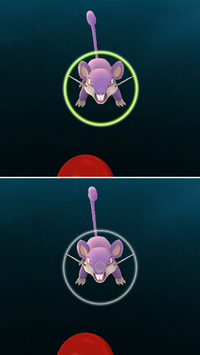Caught Pokémon (GO): Difference between revisions
(getting started on this. will add more meat as i go along) |
|||
| Line 31: | Line 31: | ||
==Encountering Pokémon== | ==Encountering Pokémon== | ||
In Pokémon GO, there are a variety of ways to encounter Pokémon. Some Pokémon are also exclusive to certain encounter methods. For instance, most [[Legendary Pokémon]] do not appear normally in the wild, and must instead be defeated and caught at [[Raid Battle]]s. | In Pokémon GO, there are a variety of ways to encounter Pokémon. Some Pokémon are also exclusive to certain encounter methods. For instance, most [[Legendary Pokémon]] do not appear normally in the wild, and must instead be defeated and caught at [[Raid Battle]]s. Once caught, the Pokémon's encounter method, along with the time and location where it was caught, can be seen at the bottom of its summary view. | ||
Each method of encountering Pokémon has its own set of properties that affect the [[Power Up|level]] and the minimum possible {{IV}} for each stat. For encounters that involve {{OBP|weather|GO}} boosts, the level is 5 higher than what it normally is (including any level caps), and the minimum IV is set to 4 (unless the minimum IV was already higher). Many encounter types also do not involve the wild Pokémon fleeing. | |||
{| class="roundy" style="background:#{{night color}}; border:3px solid #{{blue color light}}; text-align:center; caption-side:bottom;" | |||
|- style="background-color:#{{blue color light}}; color:#fff" | |||
! style="{{roundytl|5px}}; width:220px;"| Encounter method | |||
! style="width:60px;" | Level | |||
! style="width:60px;" | Min. IV | |||
! style="width:80px;" | Weather Boost | |||
! style="{{roundytr|5px}}" | Can Flee | |||
|- style="background-color:#{{blue color light}}; color:#fff" | |||
|- style=background:#fff | |||
| In the {{pkmn2|wild}} | |||
| 1 to 30<sup>†</sup> | |||
| 0 | |||
| ✔ | |||
| ✔ | |||
|- style=background:#fff | |||
| [[Pokémon Egg|Hatch an Egg]] | |||
| 20<sup>†</sup> | |||
| 10 | |||
| | |||
| | |||
|- style=background:#fff | |||
| Complete a {{OBP|Research|GO}} task | |||
| 15 | |||
| 10 | |||
| | |||
| | |||
|- style=background:#fff | |||
| Win a [[Raid Battle (GO)|raid]] | |||
| 20 | |||
| 10 | |||
| ✔ | |||
| ~ | |||
|- style=background:#fff | |||
| Defeat [[Team GO Rocket]] member | |||
| 8 | |||
| 0 | |||
| ✔ | |||
| ~ | |||
|- style=background:#fff | |||
| Defeat a {{OBP|Giovanni|GO}} | |||
| 8 | |||
| 6 | |||
| ✔ | |||
| ~ | |||
|- style=background:#fff | |||
| Surprise encounter | |||
| 1 to 30<sup>†</sup> | |||
| 0 | |||
| | |||
| ✔ | |||
|- style=background:#fff | |||
| [[GO Battle League]] | |||
| 20 | |||
| 10<sup>‡</sup> | |||
| | |||
| | |||
|- style=background:#fff | |||
| Vivillon Collector {{OBP|medal|GO}} | |||
| 15 | |||
| 10 | |||
| | |||
| | |||
|+ style="text-align:left; font-size:80%" | | |||
* †: This encounter level is capped at the player's Trainer level. | |||
** For Eggs, this is based on the player's level at the time the Egg was obtained, not hatched. | |||
** For weather-boosted Pokémon, this cap is the player's Trainer level + 5 | |||
* ‡: On GO Battle days, the IV floor is 0 for most Pokémon. | |||
* ~: This Pokémon will only flee once the player runs out of [[Premier Ball]]s during a bonus challenge. | |||
|} | |||
===In the wild=== | ===In the wild=== | ||
Revision as of 19:30, 21 January 2023

|
This article is incomplete. Please feel free to edit this article to add missing information and complete it. Reason: Further details on catching mechanics and different encounter types. |

Pokémon GO has its own catching mechanic, distinct from that of the core series games. The catching process revolves around accurately throwing a Poké Ball at a wild Pokémon, and it does not involve weakening the Pokémon in battle.
Catching mechanics
When pressing and holding down the Poké Ball, on the bottom of the screen, a colored target ring will appear in front of the wild Pokémon, constantly shrinking and immediately returning to its full size once it reaches the smallest size. The goal is to hit the Pokémon with a Poké Ball inside the target ring, when it is as small as possible, by flicking the ball towards the Pokémon. The smaller the ring when hit, the better the capture rate and the more XP is gained. Players can further increase their odds of capture using Berries, higher-level Poké Balls, or by throwing Curveballs.
- See also: Catch rate (GO)
During an encounter, a wild Pokémon may dodge or deflect the player's Poké Balls, or even flee after an unsuccessful capture attempt. If the wild Pokémon is dodging, it can still be hit with a Poké Ball, but the ball may miss if the Pokémon leaves its trajectory in time. If the Pokémon is attacking, the ball will be deflected until after the animation is completed. In addition, every Pokémon species has its own "movement type" that dictates how it dodges Poké Balls.
| Movement type | Details |
|---|---|
| Jump | Jump up and then immediately land back down. |
| Hovering | Move to the left or right if at default center. Move to the center if at left or right. |
| Flying | Fly upward if at default position. Fly downward if at upward position. |
| Electric | Move short distances in random directions, then return to default position. |
| Psychic | Move side-to-side in a figure-8 (∞) motion. |
| None | Does not move from default position. |
Encountering Pokémon
In Pokémon GO, there are a variety of ways to encounter Pokémon. Some Pokémon are also exclusive to certain encounter methods. For instance, most Legendary Pokémon do not appear normally in the wild, and must instead be defeated and caught at Raid Battles. Once caught, the Pokémon's encounter method, along with the time and location where it was caught, can be seen at the bottom of its summary view.
Each method of encountering Pokémon has its own set of properties that affect the level and the minimum possible IV for each stat. For encounters that involve weather boosts, the level is 5 higher than what it normally is (including any level caps), and the minimum IV is set to 4 (unless the minimum IV was already higher). Many encounter types also do not involve the wild Pokémon fleeing.
| Encounter method | Level | Min. IV | Weather Boost | Can Flee |
|---|---|---|---|---|
| In the wild | 1 to 30† | 0 | ✔ | ✔ |
| Hatch an Egg | 20† | 10 | ||
| Complete a Research task | 15 | 10 | ||
| Win a raid | 20 | 10 | ✔ | ~ |
| Defeat Team GO Rocket member | 8 | 0 | ✔ | ~ |
| Defeat a Giovanni | 8 | 6 | ✔ | ~ |
| Surprise encounter | 1 to 30† | 0 | ✔ | |
| GO Battle League | 20 | 10‡ | ||
| Vivillon Collector medal | 15 | 10 |
In the wild
The most common way to encounter Pokémon is standard wild encounters. When the player is walking in the overworld, a Pokémon may spawn nearby on the map, as a symbol encounter. The player can tap that Pokémon to initiate a capture encounter.
Players can also increase the rate of encountering these Pokémon by using Incenses or Lure Modules.
Certain species of Pokémon only spawn under special circumstances, as a gimmick specific to the Pokémon's species.
Ditto
Wild Ditto will always appear disguised as another species of Pokémon, alluding to its use of Transform. It will only reveal itself as a Ditto once caught.
Zorua
Wild Zorua will always appear disguised as the player's Buddy Pokémon, alluding to its Ability Illusion in the core series. The disguise even retains any Shiny forms or Mega Evolutions. Once Zorua is caught, it will reveal itself as Zorua.
Kecleon
Wild Kecleon occasionally appears at PokéStops. If Kecleon is at a PokéStop, then it will be resting on the photo disc while invisible. If the player tries to spin the photo disc, they'll be informed that something is in its way. The player can tap on Kecleon so it will hop off the PokéStop. Once the player exits the PokéStop interaction, a wild Kecleon will spawn in the overworld.
Meltan
Wild Meltan will only appear if the player has the Mystery Box active.
Hatching Eggs
- Main article: List of Eggs (GO)
The player can obtain Eggs at PokéStops, Gyms, or as a possible Adventure Sync reward. An Egg will hatch after traveling a certain distance while the Egg is in an Egg Incubator. Five Egg distances are possible: 2 km, 5 km, 7 km, 10 km, and 12 km. 7 km Eggs are exclusively obtained by opening Gifts, and 12 km Eggs are obtained by beating Team GO Rocket Leaders. 2 km, 5 km, and 10 km eggs are obtained from Pokéstops and Gyms, but if a trainer walks enough in a week, they'll get an egg from Adventure Sync. This includes walking 25 km for a 5 km egg, or walking 50 km for a 10 km egg. The eggs from Adventure Sync have different Pokémon that can hatch from them. Each species has a set Egg distance and can only hatch from Eggs with this distance, but Egg distances have occasionally been changed.
Research tasks
- Main article: Research (GO)
Many Research tasks in Pokémon GO reward encounters with a specific wild Pokémon.
Surprise encounters
Occasionally while using the GO Snapshot feature, a wild Pokémon may photobomb the picture. Afterwards, that Pokémon will spawn in the overworld. Surprise encounters are not affected by weather boosts, and may flee from the encounter.
Normally, only Smeargle can appear as the surprise encounter and only up to once per day. However, during many special events such as Community Days, a different Pokémon, usually one featured in the event, may be encountered instead.
Team GO Rocket
After defeating a Team GO Rocket member, the player will have a chance to capture one of the Shadow Pokémon they used in battle.
GO Battle League
Rewards for winning battles in GO Battle League may include encounters with wild Pokémon.
Pinning postcards
Scatterbug is exclusively obtained by pinning postcards from Gifts. The Vivillon Collector medal uniquely tracks points for each of Vivillon's eighteen patterns (excluding Fancy Pattern and Poké Ball Pattern). Whenever the player pins a postcard, a point is added to the medal, towards the pattern that corresponds to the postcard's location of origin. Once the Vivillon Collector medal has accumulated enough points for a specific pattern, it will unlock an encounter with a Scatterbug, whose final evolution is a Vivillon with that pattern.

|
This article is part of Project Sidegames, a Bulbapedia project that aims to write comprehensive articles on the Pokémon Sidegames. |

